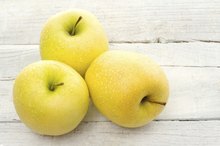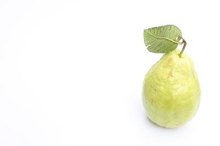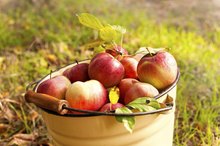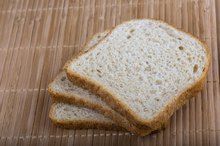What does fact checked mean?
At Healthfully, we strive to deliver objective content that is accurate and up-to-date. Our team periodically reviews articles in order to ensure content quality. The sources cited below consist of evidence from peer-reviewed journals, prominent medical organizations, academic associations, and government data.
The information contained on this site is for informational purposes only, and should not be used as a substitute for the advice of a professional health care provider. Please check with the appropriate physician regarding health questions and concerns. Although we strive to deliver accurate and up-to-date information, no guarantee to that effect is made.
Starch in Apples
When you bite into and enjoy the sweet taste of an apple, you are eating what was once a starch, or carbohydrate. The carbohydrate is converted into sweeter-tasting sugar as your apple ripens and matures. The effects of starch on apples determine when they're ripe and ready to eat.
Starch Significance
Starch is categorized as a carbohydrate, which means it can be broken down into smaller sugar components. If you write out the chemical composition of a starch molecule, it has repeating glucose -- starch -- units. Apples aren’t the only food that contains starch. Potatoes, corn and wheat all have starch as a component. Starch is similar to another chemical, cellulose, found in fruit and vegetable peels, like the peel of an apple. Like starch, cellulose gives foods a crunchy, fibrous texture.
- Starch is categorized as a carbohydrate, which means it can be broken down into smaller sugar components.
Ripening
How to Ripen Oranges in the Microwave
Learn More
You can tell how ripe an apple is by how much starch it contains. A very ripe apple will contain little starch, while a young apple will be mostly starch, particularly when compared to sugar. As an apple ripens, the starch is converted into sugar, so the fruit grows more palatable as it ripens. The conversion process starts at the apple’s core, then progresses outward to the apple’s skin.
- You can tell how ripe an apple is by how much starch it contains.
- A very ripe apple will contain little starch, while a young apple will be mostly starch, particularly when compared to sugar.
Iodine Test
You can tell the level of starch in a particular batch of apples by conducting a simple iodine test. Cut an apple in half, then brush brown iodine, which is available at most health food and medical supply stores, over the apple. You should notice the brown color starting to turn purple in some areas. The purple portions indicate the presence of starch in the apple. If your apple has few regions of purple starch, this indicates ripeness, according to Nova Scotia Apples 1.
- You can tell the level of starch in a particular batch of apples by conducting a simple iodine test.
- Cut an apple in half, then brush brown iodine, which is available at most health food and medical supply stores, over the apple.
Flavor
Apple Allergy Symptoms
Learn More
The presence or lack of starch can affect an apple’s flavor. An apple that has not had sufficient time to ripen may lack sweetness because more starch is present than sugar. As an apple matures, the increasing amount of sugar will cause a sweeter flavor. This does not mean apples are a significant source of sugar, however. Apples rate rather low on the glycemic index that measures sugars in food, particularly when compared to high-sugar fruits. Apples have a glycemic load of 6 per serving, which is very low compared to raisins, which have a glycemic load of 28, or a ripe banana, which has a glycemic load of 13, according to Harvard Health Publications 5.
- The presence or lack of starch can affect an apple’s flavor.
- Apples rate rather low on the glycemic index that measures sugars in food, particularly when compared to high-sugar fruits.
Related Articles
References
- Nova Scotia Apples: Apple Chemistry
- "Illinois AgMag": Apple
- "Food Chemistry"; Characterization of Starch in Apple Juice and Its Degradation by Amylases; M. Carrin, et al.; January 2004
- Polymer Science Learning Center; Starch; 2005
- Harvard Health Publications; Glycemic Index and Glycemic Load for 100+ Foods; 2011
- Al-Mana, N. M., & Robertson, M. D. (2018). Acute Effect of Resistant Starch on Food Intake, Appetite and Satiety in Overweight/Obese Males. Nutrients, 10(12), 1993. doi:10.3390/nu10121993
- Bindels, L. B., Segura Munoz, R. R., Gomes-Neto, J. C., Mutemberezi, V., Martínez, I., Salazar, N., … Ramer-Tait, A. E. (2017). Resistant starch can improve insulin sensitivity independently of the gut microbiota. Microbiome, 5(1), 12. doi:10.1186/s40168-017-0230-5
- Canani, R. B., Costanzo, M. D., Leone, L., Pedata, M., Meli, R., & Calignano, A. (2011). Potential beneficial effects of butyrate in intestinal and extraintestinal diseases. World journal of gastroenterology, 17(12), 1519–1528. doi:10.3748/wjg.v17.i12.1519
- Haub, M. D., Hubach, K. L., Al-Tamimi, E. K., Ornelas, S., & Seib, P. A. (2010). Different types of resistant starch elicit different glucose reponses in humans. Journal of nutrition and metabolism, 2010, 230501. doi:10.1155/2010/230501
- Brighenti, Furio et al. " Colonic fermentation of indigestible carbohydrates contributes to the second-meal effect." American Journal of Clinical Nutrition 83.4 (2006): 817-822.
- Cummings, JH. "The Large Intestine in Nutrition and Disease: (monograph), December 1996, ISBN 2-930151-02-1.
- Englyst, Klaus, et al. "Glycaemic index of cereal products explained by their content of rapidly and slowly available glucose." British Journal of Nutrition. 89 (2003):329-339.
- Englyst, Klaus and Englyst, Hans. "Carbohydrate Bioavailability." British Journal of Nutrition 94 (2005): 1-11.
- Higgins, Janine, et al. "Resistant starch consumption promotes lipid oxidation." Nutrition and Metabolism 1.8 (2004): 1743-7075.
- Higgins, Janine. "Resistant Starch: Metabolic Effects and Potential Health Benefits." Journal of AOAC International 87 (2004):761-8.
- Robertson, M.D. et al. "Prior Short-Term Consumption of Resistant Starch Enhances Postprandial Insulin Sensitivity in Healthy Subjects." Diabetologia 46 (2003): 659-665.
Writer Bio
Rachel Nall began writing in 2003. She is a former managing editor for custom health publications, including physician journals. She has written for The Associated Press and "Jezebel," "Charleston," "Chatter" and "Reach" magazines. Nall is currently pursuing her Bachelor of Science in Nursing at the University of Tennessee.









